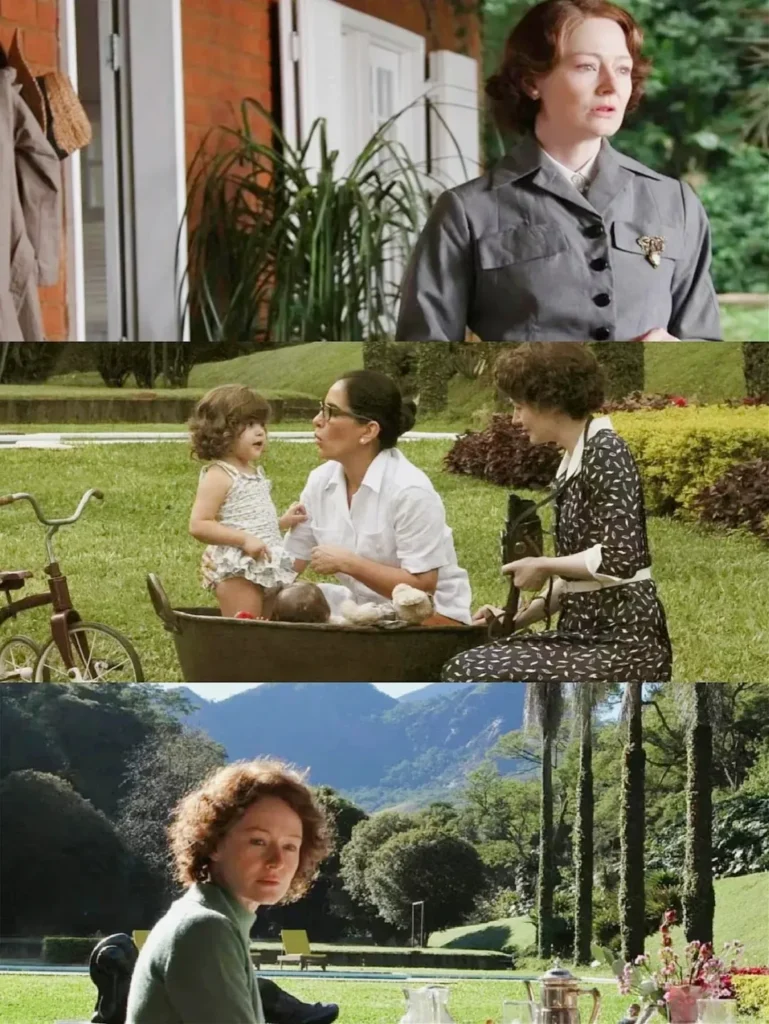Reaching for the Moon (Flores Raras) is a Brazilian lesbian movie that is both beautiful and heartbreaking. It mixes poetry, architecture, and forbidden love. The movie is about the lives of Pulitzer Prize-winning poet Elizabeth Bishop and her passionate but troubled relationship with Brazilian architect Lota de Macedo Soares. Set in the beautiful Rio de Janeiro, it weaves together personal love, creative inspiration, and tragedy that can’t be avoided. This makes it one of the most beautiful lesbian biographical plays of the 21st century.

In the 1950s, American poet Elizabeth Bishop travels to Rio de Janeiro in search of inspiration. Invited by her old friend Mary, she meets Mary’s partner, the charismatic architect Lota. Despite her initial shyness and reliance on alcohol to open up, Elizabeth and Lota fall into a passionate affair. Their love inspires some of Bishop’s most enduring poetry, while Lota designs breathtaking architectural projects—including the iconic Flamengo Park in Rio.

Yet, what begins as a romance full of vitality turns fragile. Bishop gains international recognition, winning the Pulitzer Prize and becoming increasingly self-assured, while Lota, once fiercely confident, begins to crumble under political pressures and personal insecurities. Their relationship—marked by love, dependency, artistic expression, and pride—spirals toward inevitable tragedy, leaving behind luminous poetry, haunting architecture, and the ache of “the art of losing.”
Reaching for the Moon Movie Cast
Charactor

A Pulitzer Prize–winning American poet, fragile, shy, and often reliant on alcohol to lower her defenses. Her love for Lota inspired some of her most celebrated works.
Miranda Otto
Miranda Otto (The Lord of the Rings: The Two Towers, The Chilling Adventures of Sabrina) is mesmerizing here—transforming from pale fragility into artistic brilliance. Her portrayal balances Bishop’s vulnerability with sharp wit, making her heartbreak tangible.

A bold Brazilian architect, passionate and ambitious, who designed Rio’s Flamengo Park. Fiercely confident yet deeply insecure beneath her strength, she becomes both Bishop’s muse and her destroyer.
Gloria Pires
Gloria Pires, one of Brazil’s most acclaimed actresses, imbues Lota with charisma and complexity—part lover, part dictator, part tragic heroine.
Director

Bruno Barreto
Bruno Barreto is a veteran Brazilian filmmaker best known for Dona Flor and Her Two Husbands (1976), a landmark of Brazilian cinema. Over his long career, he has often explored the intersections of Brazilian culture and universal human emotions. With Reaching for the Moon (2013), Barreto turned to a more intimate story, portraying the love affair between Elizabeth Bishop and Lota de Macedo Soares with a mix of lyrical beauty and emotional restraint. His direction captures both the lush atmosphere of Rio de Janeiro and the fragile interior worlds of two women whose passion shaped art, architecture, and poetry.
BEST SCENES
📍 The bathtub scene is unforgettable: Elizabeth washes Lota’s hair, turning an everyday gesture into luminous poetry. Bishop’s verses—“The shooting stars in your black hair… let me wash it in this big tin basin, battered and shiny like the moon”—capture both tenderness and the fragility of their bond. It’s intimate, symbolic, and visually breathtaking.
Reaching for the Moon Review
Review





⭐ Story (Score: 4/5)
The film beautifully adapts real history into a love story brimming with contrasts—cold moonlight and blazing sun, shyness and arrogance, poetry and architecture. It is both a tale of artistic triumph and emotional collapse. However, some viewers may find its pacing slow and its focus scattered between personal love and political background.
⭐ Acting (Score: 4.5/5)
Miranda Otto delivers a stunning performance as Elizabeth Bishop—her husky voice and delicate gestures embody the poet’s fragility and hidden fire. Gloria Pires as Lota radiates charisma, passion, and stubborn pride, creating a magnetic yet volatile counterpart. Together, they carry the film’s intensity.
⭐ Chemistry (Score: 4/5)
The push-and-pull between Bishop’s emotional reserve and Lota’s controlling passion feels raw and believable. Their intimacy is tender yet suffocating, their dependency both healing and destructive. The imbalance becomes the heart of the drama.
⭐ Production (Score: 4/5)
Bruno Barreto’s direction highlights Brazil’s landscapes, the lyrical light of Rio’s coastline, and Bishop’s words woven into the narrative. The score (including cheerful Brazilian songs and Bishop’s poems read aloud) elevates the mood. At times, the film feels overly polished, but its elegance is undeniable.
⭐ Ending (Score: 4/5)
The ending is heartbreaking yet inevitable. Lota’s collapse in a psychiatric hospital and the unspoken words between the lovers drive home the tragedy of two women who could inspire but not save each other. It lingers like a melancholy poem.
💬 My Take
Watching Reaching for the Moon felt like reading one of Bishop’s poems—restrained, polished, yet full of hidden storms. What touched me most was how love became both women’s undoing: Bishop, once shy and dependent, found strength through Lota; while Lota, once powerful and admired, crumbled under the fear of losing Bishop. The irony is painful, yet deeply human.
I also felt the film asks us a universal question: why do we write poems or build monuments instead of simply saying I love you? Bishop expressed affection through verses, Lota through buildings. But in love, sometimes the simplest words matter more than any masterpiece. This contradiction is what makes their story unforgettable.
